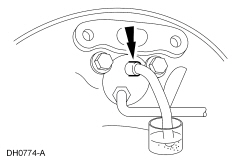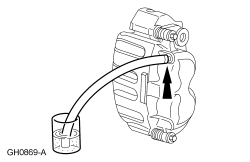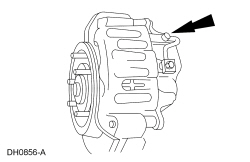Ford Focus Service Manual: Brake System Bleeding

|
Vehicle Communication Module (VCM) and Integrated Diagnostic System (IDS) software with appropriate hardware, or equivalent scan tool |
| Item | Specification |
|---|---|
| Motorcraft® High Performance DOT 3 Motor Vehicle Brake Fluid (US) / Motorcraft® Brake Fluid - Heavy Duty DOT 3 (Canada) PM-1-C (US); CPM-1-C (Canada) | WSS-M6C62-A or WSS-M6C65-A1 |
Pressure Bleeding
 WARNING: Do not
WARNING: Do not
use any fluid other than clean brake fluid meeting manufacturer's specification.
Additionally, do not use brake fluid that has been previously drained. Following
these instructions will help prevent system contamination, brake component damage
and the risk of serious personal injury.
 WARNING: Carefully
WARNING: Carefully
read cautionary information on product label. For emergency medical information
seek medical advice. In the USA or Canada on Ford/Motorcraft products call: 1-800-959-3673.
For additional information, consult the product Material Safety Data Sheet (MSDS)
if available. Failure to follow these instructions may result in serious personal
injury.
 WARNING: Do not
WARNING: Do not
allow the brake master cylinder to run dry during the bleeding operation. Master
cylinder may be damaged if operated without fluid, resulting in degraded braking
performance. Failure to follow this instruction may result in serious personal injury.
NOTICE: Do not spill brake fluid on painted or plastic surfaces or damage to the surface may occur. If brake fluid is spilled onto a painted or plastic surface, immediately wash the surface with water.
NOTE:
The Hydraulic Control Unit (HCU) bleeding procedure must be carried out if the HCU or any components upstream of the HCU are installed new.
NOTE:
Pressure bleeding the brake system is preferred to manual bleeding.
- Clean all dirt from the brake master cylinder filler cap and remove the
filler cap.
- Fill the brake master cylinder reservoir with clean, specified brake fluid.
- NOTE:
Master cylinder pressure bleeder adapter tools are available from various manufacturers of pressure bleeding equipment. Follow the instructions of the manufacturer when installing the adapter.
Install the bleeder adapter to the brake master cylinder reservoir, and attach the bleeder tank hose to the fitting on the adapter.
- NOTE:
Make sure the bleeder tank contains enough clean, specified brake fluid to complete the bleeding operation.
Open the valve on the bleeder tank.
- Apply 207-345 kPa (30-50 psi) to the brake system.

- Remove the RR bleeder screw cap and place a box-end wrench on the bleeder screw. Attach a rubber drain hose to the RR bleeder screw and submerge the free end of the hose in a container partially filled with clean, specified brake fluid.
- Loosen the RR bleeder screw. Leave open until clear, bubble-free brake fluid flows, then tighten the RR bleeder screw to specifications. Refer to Specifications in this section. Remove the rubber hose.
- Continue bleeding the rest of the system, going in order from the LR bleeder
screw to the RF bleeder screw, ending with the LF bleeder screw.
- Tighten the brake caliper and wheel cylinder bleeder screws to specifications. Refer to Specifications in this section.
- Close the bleeder tank valve. Remove the tank hose from the adapter and remove the adapter. Fill the reservoir with clean, specified brake fluid and install the reservoir cap.
Manual Bleeding
 WARNING: Do not
WARNING: Do not
use any fluid other than clean brake fluid meeting manufacturer's specification.
Additionally, do not use brake fluid that has been previously drained. Following
these instructions will help prevent system contamination, brake component damage
and the risk of serious personal injury.
 WARNING: Carefully
WARNING: Carefully
read cautionary information on product label. For emergency medical information
seek medical advice. In the USA or Canada on Ford/Motorcraft products call: 1-800-959-3673.
For additional information, consult the product Material Safety Data Sheet (MSDS)
if available. Failure to follow these instructions may result in serious personal
injury.
 WARNING: Do not
WARNING: Do not
allow the brake master cylinder to run dry during the bleeding operation. Master
cylinder may be damaged if operated without fluid, resulting in degraded braking
performance. Failure to follow this instruction may result in serious personal injury.
NOTICE: Do not spill brake fluid on painted or plastic surfaces or damage to the surface may occur. If brake fluid is spilled onto a painted or plastic surface, immediately wash the surface with water.
NOTE:
Pressure bleeding the brake system is preferred to manual bleeding.
- Clean all the dirt from around the brake fluid reservoir cap and remove
the filler cap.
- Fill the brake master cylinder reservoir with clean, specified brake fluid.
- Remove the RR bleeder screw cap and place a box-end wrench on the bleeder screw. Attach a rubber drain hose to the RR bleeder screw and submerge the free end of the hose in a container partially filled with clean, specified brake fluid.

- Have an assistant pump and then hold firm pressure on the brake pedal.
- Loosen the RR bleeder screw until a stream of brake fluid comes out. While
an assistant maintains pressure on the brake pedal, tighten the RR bleeder screw.
- Repeat until clear, bubble-free fluid comes out.
- Refill the brake master cylinder reservoir as necessary.
- Tighten the RR bleeder screw to specifications. Refer to Specifications in this section. Remove the rubber hose and install the bleeder screw cap.
- Repeat Steps 2 through 5 for the LR bleeder screw.
- Remove the RF bleeder cap and place a box-end wrench on the bleeder screw. Attach a rubber drain hose to the RF bleeder screw and submerge the free end of the hose in a container partially filled with clean, specified brake fluid.

- Have an assistant pump and then hold firm pressure on the brake pedal.
- Loosen the RF bleeder screw until a stream of brake fluid comes out. While
the assistant maintains pressure on the brake pedal, tighten the RF bleeder
screw.
- Repeat until clear, bubble-free fluid comes out.
- Refill the brake master cylinder reservoir as necessary.
- Tighten the RF bleeder screw to specifications. Refer to Specifications in this section. Remove the rubber hose and install the bleeder screw cap.

- Repeat Steps 7 through 10 for the LF bleeder screw.
Hydraulic Control Unit (HCU) Bleeding
 WARNING: Do not
WARNING: Do not
use any fluid other than clean brake fluid meeting manufacturer's specification.
Additionally, do not use brake fluid that has been previously drained. Following
these instructions will help prevent system contamination, brake component damage
and the risk of serious personal injury.
 WARNING: Carefully
WARNING: Carefully
read cautionary information on product label. For emergency medical information
seek medical advice. In the USA or Canada on Ford/Motorcraft products call: 1-800-959-3673.
For additional information, consult the product Material Safety Data Sheet (MSDS)
if available. Failure to follow these instructions may result in serious personal
injury.
 WARNING: Do not
WARNING: Do not
allow the brake master cylinder to run dry during the bleeding operation. Master
cylinder may be damaged if operated without fluid, resulting in degraded braking
performance. Failure to follow this instruction may result in serious personal injury.
NOTICE: Do not spill brake fluid on painted or plastic surfaces or damage to the surface may occur. If brake fluid is spilled onto a painted or plastic surface, immediately wash the surface with water.
NOTE:
Pressure bleeding the brake system is preferred to manual bleeding.
- Follow the Pressure Bleeding or Manual Bleeding procedure steps to bleed the system.
- Connect the scan tool and follow the ABS Service Bleed instructions.
- Repeat the Pressure Bleeding or Manual Bleeding procedure steps to bleed the system.
 Brake System - General Information
Brake System - General Information
The brake system consists of the following components:
Fixed brake pedal
Front disc brake system
Brake master cylinder and fluid reservoir
Mechanical parking brake system
ABS
Rear ...
 Brake System Inspection
Brake System Inspection
Material
Item
Specification
Motorcraft® Metal Brake Parts Cleaner (US) / Motorcraft® Brake Parts
Cleaner (Canada)
PM-4-A or PM-4-B (US); CPM-4 (Canada)
—
...
More about Ford Focus:
Ford Focus Seat - Front
NOTE: LH shown, RH similar.
Item
Part Number
Description
1
61749
Seat track trim cover
2
W708175
Seat bolt (3 required)
3
N802068
Seat nut
4
W713480
Seat stud
5
—
Electrical connector (pa ...
